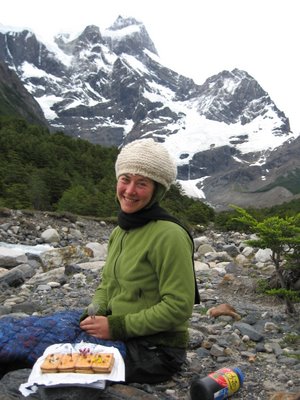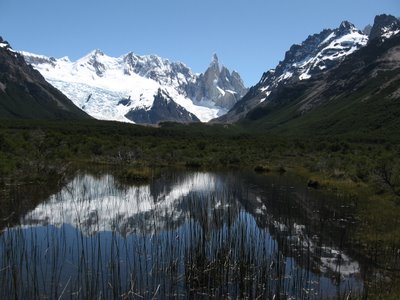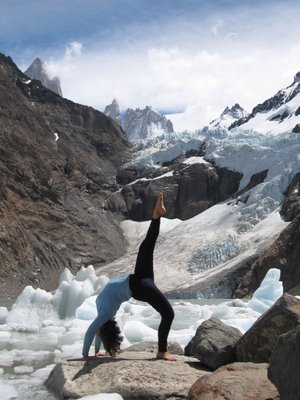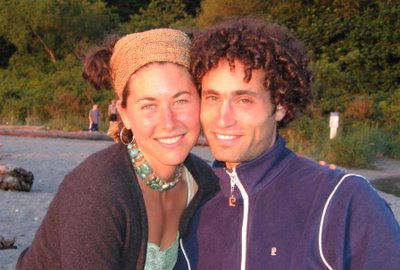torres del paine, parte uno





Through the fogged windows of the bus we stared flatly out at the grey porridge morning. Feeling that deep inside mix of excitement and unease as we took the early transfer to the Torres del Paine National Park. Excited and equipped to hike 120km over 9 days and a bit worried that not a single distinct shape could be made out thru the heavy fog and condensed breath. Without even discussing it we knew we wanted to hike the full circuit around this far southern chilean mountain range. It would be the longest hike either of us had ever taken. 9 days of food would weigh us down. Weather, we had heard so many times, was extremely unstable. Torrents of rain, crippling winds, even snowstorms were possible at any time of the year. All this sat in my mind as we exited the bus into the misty morning. After slipping into our rain gear, we feasted on the last fresh food for 9 long days. True to the talk, as we finished the last hard boiled egg and avocado, the skies lightened and the drizzle slowed. We hit the trail with a kiss and an energized excitement. After a few detours we came out of a dusty ascent into a sun-specked field of daisies waving whimsically in the breeze, and settled in for a rest. Over the next 3 days the trail climbed and descended into lush valleys, traversing muddy flats and high rocky ridges. We drank straight from the rivers rushing out of the Torre mountains, which stood always to our left as we circumnavigated them. The weather was fine; rain, then sun, then rain and sun again...
At the end of the third day we stayed at our first official campsite and took cold outdoor showers to the bemusement of the staff and other hikers. The next day we would cross the pass.
El paso John Garner rises to only a bit over 6000 feet, but at this latitude that is significant. We woke early to a cold windy drizzling morning and ate a hearty breakfast, hitting the trail at 8:30. As quick as we rose above the tree line, the wind swooped in. We bent against the gusts, heads down, hoods cinched up tight. Struggling up scree slopes or hopping boulders, the wind incessantly blew in our faces - slowing us, frustrating us, chilling the cheeks, and irritating the eyes. Higher we climbed over loose, naked rock, raising our eyes with difficulty to spot the small orange marker stones and cairns. The unending wind whipped over the pass, a low saddle surrounded by sharp peaks. As we neared it, the temperature dropped and the intermittent gusts became so strong that Tamara actually fell over a few times. It was difficult, but not impossible, and i revelled in the raw power: THIS is Patagonia! i yelled into the maw of the mountain.
Heads down, concentrating only on placing on foot in front of the other, we crossed a small snowfield to reach the pass - marked unceremoniously by a pile of rocks. No wonder. Even to raise the eyes a moment meant a blast of high velocity frozen rain that seemed to scour any exposed skin.
Still headlong into the wind, we let gravity pull us downhill as the wind held us upright: descending weightlessly until small scrubs curbed the wind and we could look up.
The sight occurred to us more than it hit us. Eyes stinging from the pass, legs wobbly, we sat and gazed out over an extraterrestrial landscape. Glacier Grey filled the balley below us. With no way to judge its scale, it appeared like a mirage or a window into another world. The glacier indeed is its own world. Flat smooth plains of ice bisected by slowly flowing rivers of ice carving their way downwards towards the front face of the glacier at Lago Grey. Farther out, crevasses break the open fields of white ice. Further still, cracks appear and mountains of ice bulge upwards. Deeper into this frozen world, sharp spires of dense-blue ice pierce the surface, commanding one´s attention and imaginings. I sat and pictured myself exploring this world on foot - how sublime and still and strange it must be close up.
Tamara writes in her journal:
To our left was Lago Grey, stretching out in the distance, to our Right the icefield moving-on seemingly infinitely. We were at a vantage point, close enough to the icefield to make out the texture and colorful magnificence. The dark blue pools of water/ice between the stark white ridges. The sheer beauty brought me to tears. So magnificent, it was the greatest work of art I had ever seen. The ancient ice moving with a quality of unfathomable slowness brought shivers down my spine. I felt as if I were looking out on a new world, or more accurately an ancient one. Lifeless, stark, and utterly stunning. This was not a human world.
torres del paine, parte dos



We camped that nite in the rain, falling asleep gratefully grounded after a shared meal with new friends.
By the fifth day, we felt really in the groove. It was so easy to fall into a brisk hiking pace and the thrill of the pass seemed to fuel us. We had accumulated a sort of collected momentum; an internal locomotion fueled by this kinetic energy. The wind was figuratively at our backs. We rolled up hills effortlessly and steep inlcines burned the legs without extinguishing this well of power; the fruitof the struggle over the pass.
The weather was glorious - warm, clear days that brought us in and out of deep river valleys as we circled the mountains which now stood to the east of us. But with the good weather, we also hit the `W`: a 3 to 4 day hike that most choose over the complete circuit. Its accessible by boat, so we passed tour groups in never-used North Face, leaving them in our gloriously stinky wake.

We celebrated Tamara´s 28th birthday with a HOT shower (surreptitiously enjoyed at one of the fancy lodges.) Then, later

, a tasty meal topped off with the surprise I´d been carrying for 6 days: a no bake birthday cake. Just dip your biscuits briefly in water to build a base, layer with dulce de leche, top with apricot jelly and coconut, and garnish with local wildflowers and a match in place of a candle.
¡Feliz Cumpleaños Tamara!
After three days of sun, we escaped just as a burly storm came whipping in. Good timing, right? Well, with all the sun the glaciers melted and then a nite of heavy rain (during which we barely slept, as the tent whipped and cracked and pulled out stakes), we woke to swollen streams and chilly crossings. Hiked the whole day in the chaco sandals and were feeling good til we got to the river. Normally an easy crossing with the wire strung across for a little guidance, today it was insane. We crested the hill to the sight of it, and it took even me a few minutes to convince myself it could actually be done. i mean, we werent going to walk BACK over 100 kilometers and a KaRazy pass just 10k from our destination. So, what did we do? We took off our clothes. Yup, stripped to the waist, transferred the sleeping bags into the top of the pack, hitched the pack up around the nipples, and stepped into the freezing rushing waters muddy with run off and glacial dust. It really was sketchy, a fall and we would be tumbling down stream with a heavy pack. Even if we could hold onto the wire, with our feet swept out, there´d be no way to hold on.
I stepped in, immediately feeling that sharp pain of frigid water, before the numb comes. Carefully placing my steps, trying to breathe and stay calm as the cold and the danger sucked out the breath. In the middle, the water was pounding insistently, waist-deep. But i took my time, made it to the higher rocks mid stream, and watched tamara move thru a moment of fear, revealed in her face, to join me. The second branch of the stream was relatively easier, and we flopped on the ground, shivering on the other side (but not before i snapped a pic of tamara nearly across.) great last day of a long hike!
it was amazing: in turn beautiful, quiet, sublime, raw, cold, windy, meditational, intense, exhausting, invigorating, super challenging, scary, even dangerous, and finally so rewarding.
Carretera Austral

everytime we leave argentina, we are pummeled by rain. A month and a half ago from uruguay, we were shaken from sleep at 5am and ushered off the bus into darkness and a torrent of heavy, driving rain; left at the side of the road, our only shelter the soon-arriving, over-priced taxi.this time, we were delivered to the frontier in the back of a pick up truckk, 10km past the destination of the amiable family in the cab. We walked in full rain gear, crossing the kilometer that is neither argentina nor chile, in a swirling mist. Since then, the rain hasnt ceased.We spent a few days on the unheated floor of some rafting guides, then headed south on the carretera austral: a would-be road connecting distant settlements in remote southern chile. for now, its a 2000km long mud pit. The road snakes thru glorious mtn scenery, lush forests, steep peaks, glaciers, and fjords. Or, at least weve been told.We did see the thick, dripping forests of verdant green. but raising our eyes, the trees faded into ghostly mists and sheets of rain. We decided to brave the elements at Queulat national park. We were told it always rains here, so why not camp now? We set up camp at 8am under a slanted tin roof for tents (a godsend!) and over the next two days it rained 97% of the time. But that first morning ws beautiful. The rain slowed, the mist lifted, and we set off on the muddy trail to the viewpoint.The trek thru dripping forests and ankle deep mud was rewarded two hours later. We emerged at a cliffside clearing to views across a steep valley to the ventisquero colgante: a massive hanging glacier glistening turquoise blue against the overcast sky. Me and T sat damply on a log, mesmerized by the spires of ice, shining blue as if illuminated from within. After a time, we were shaken by the awesome sight of a piece of the glacier cracking and toppling hundreds of feet to the rock face, shattering, and reigning down a thousand feet to the glacier-green lake below.With that, we headed down, arriving thoroughly wet (our waterproof jackets revealed their inadequacy after a few hrs in the rain.) We peeled of our heavy clothes, stepped out of soggy shoes, and climbed into the tent, not emerging for 17 hrs, sleeping through the shortest night of the year; bringing the summer solsitice in the southern hemisphere.
worldbridger


¨Every time you two go to the mountains, the sun comes out,¨ Alicia, the senora said to Tamara as they hung laundry together. Weve been here at their house cum hostel (with no sign - to fly under the tax radar?) for 10 days as groups of boisterous israelis come and go. And now were buddies: she asks us to watch the house and answer the phone when she leaves and greats us by name when we come back from camping.
And she´s right: we´ve bee in no rush to quickly hike all the trails here and move on. We spend a few days in town - eating curried squash soup and drinking beer - while it rains and blows, then we decide to go for a hike and the weather turns. For a couple days, the sun shines and the grey lifts. Then we come back to our warm house - and so does the late afternoon gale-force winds and invisibly small raindrops.
We spent new years eve in bed after a hot shower and brought in 2007 with a kiss. The one ´rock´party in this dirt-road town was advertised to start at 1am, but by then we were falling asleep.
We woke early and, after tea and a few facturas (pastries) from the local bakery, we were on the trail. The slight disappointment at last nite´s lack of excitement disapated on the trail, despite the heavy grey skies. We lunched on sandwiches of hard boiled eggs, tomato, cheese, carrots, and crunchy bread as the winds swirled around us on the viewpoint which presented only hazy vistas.
By the time we arrived at poincenot camp, just 3 and a half hours later after a leisurely stroll, the famed FitzRoy Mtn had come into view. Fitz roy is often visible when Torre is obscured. We walked past the crowded camping area, and set up our ten with a spectacular view of the mtn. Of course, it was a bit windier down there but I built up a windscreen of fallen logs and we went for a late afternoon walk. it was cold and gusty up the valley and the trail petered out as we followed the rocky stream bed. We had to climb hand over hand up and over a hill to regain the trail. When the superwindy and frigid boulder field stopped tamara, I continued on to laguna sucia ¨the dirty lagoon.¨ Just as i arrived, a huge chunk of glaciated ice crashed down into the murky waters. The scene was spectacularly dismal; amazing, but too raw to stay long.
We came back to the tent and cooked dinner inside the tent to escape the wind. So much for Alicia´s analysis. By dusk, we were asleep.
I awoke with an excitement and unzipped the tent to reveal Fitz Roy clear and crisp in the dawn. When the sun´s rays first hit its peak, i layered on all my clothes and ventured out. Tamara lay curled up in her sleeping bag, watching the massive mountain glow from the warmth of bed.
Still riding the thrill of the clear morning, i hiked a steep rocky trail directly up and over a high saddle. Cresting the barren hill huffing heavily, I was greeted by the stunning sight of Fitz roy close up, looming overhead. Below, the lagun de los tres shone opal-turquiose while behind me the valley fell into the flat patagonian steppes and the sprawling, low-lying, glacial-fed lake viedma.
I scrambled down to and around the lakes shore. Crossing the swift outlet stream, i peered down dizzily into the abyss into which it fell 800 ft to laguna sucia. Over and up the loose rock on the other side i climbed, glancing down the cliff to my left until a condor soared into the crater holding the laguna and right up to the cliff, landing in its nest just 60 ft above me. I noticed it didnt have any of the white feathers on its inner wings, and figured it must be an adolescent. I climbed higher, sloping towards the nest until i decided it was too steep to climb on and risk the fall to laguna sucia, nearly 1000 feet below. As i sat studying the young bird, a full-grown condor glided silently up from the lagoon on wings spanning at least 7 feet. It turned its head, spotting me, and with a slight tilt to its massive wings swooped down upon me. I stared at it, transfixed, as it got closer and closer. I could see the white fringe around its neck, its stout beak, even its flat eye. Amazing! Until I realized maybe that was her baby and i was too close. I imagined her knocking me off balance with a blow from powerful wings, sending me tumbling gruesomely to my frigid death. I had heard that condors, primarily scavengers, were known to abduct baby sheep in their huge talons. I crouched down, fortifying my position, while holding eye contact with her liquid eye. I tried to soften myself, to seem less threating, to somehow appeal to her innate ability to differentiate a predator from a curious, harmless human. She glided even closer, perhaps 10 to 15 ft of cold air between us, and i actually readied myself for the tumbling, bruising, incapacitating, and ultimately fatal fall. Just before her wings swept me off the steep face, she lowered her head, nodding to me in acceptance. Then, without sound, banked to here right, and into the valley of laguna de los tres. Breathless and thrilled, I carefully made my way down to the trail and walked back to the tent, meditating to the rhythm of my footsteps on the condor´s role as worldbridger: taking sustenance and life from what is dead, diseased, and decayed.
divine!

El Chalten is a still-small town on the edge of Glaciares National Park, at the base of the world famous FitzRoy range. A controversial and gruesome climbing history, extremely challenging technical routes, and ease of access to the base camps makes it a very popular place.
We headed up into the hills... hikes here are not like in the Cascades. There is no sloping green foothills dotted with lakes. From town, (only 600 ft. above sea level) we followed a river gracefully snaking up for only 3 hrs before reaching the campsite (at 1800ft) at the base of a glacier. The overcast skies dropped only a light rain and the peaks surrounding the glacier-green lake were still thick with snow: spactacular but not unlike glacial lakes in the NW. We set up camp, drinking straight from the milky glacial waters rushing furiously by our site. We stayed warm in the afternoon snow flurries by strolling the rim of the moraine holding back the lake at the base of the glacier and gazing at the small icebergs blown across by the strong winds.
After an encounter with a childhood neighbor of Tamara, we went to sleep at 10pm in the dusk light.
I awoke early , ready for the clear morning, but even tho sun shined onto our tent from down-valley, heavy snow flakes hit my upturned face as i leaned out of the tent. We went for a walk, cooked oatmeal inside the tent (to shield the pitifully weak argentine stove from wind) and got ready to leave.
The climbers were more active than the day before and the primarily american dudes chatted about the rising pressure while grasping the barometer. We headed down and stopped halfway to bask in the emerging sun. Sitting on our packs, we looked at each other. You know, it seems like the weather is moving. We could see more and more of the fowing glacier. 15 mins later, a serrated ridge revealed itself. The 8000 ft. range was engulfed and partially liberated by furious winds. One, two peaks were visible. After and hour and 2 cheese sandwiches with radishes, we actually began to believe: the clouds were lifting from Cerro Torre and her 2 sister spires. This was the prize the climbers had been waiting for! (¨In two months, weve seen the top only one time,¨ they had confided in subdued tones.) Clouds rolled over the ridge, but were swept away even quicker by the powerful winds. Just watching the weather change was
moving experience. The dynamism of nature: ¨complet calm is death; our beauty lies in movement,¨said Pascal.
On our windy hill, we sat for hours watching the range thru the frame of steep peaks running the length of the valley. Then, piercing the clouds, we saw the 10,000 foot peak of the Torre spire - improbably high; impossibly connected to its base so far below.
We stayed an hour longer and our patience was rewarded. The sharp ridge was clear and bright and lower peaks on either side of Torre broke through. Then, as the wind swirled and moved the weather still clinging to the spire, the Cerro Torre was revealed in its entirety! It was stunning, stupefying. Surreal like a movie backdrop; nearly unbelievable. From the blue glacier, the rock spire rises directly heavenwards undeterred by gravity or glaciation. Mesmerizing in its majesty, like a god-hand sculpture or, rather, a divine muse!
smile at the rain

¨
The worst weather in years!¨¨It never rains this much here!¨¨¡que feo el tiempo!¨We´ve heard it everywhere weve been in patagonia. In literally every town from soggy pueblos on the carretera austral to wind-whipped villages in southern argentina, locals are amazed at the extremity of weather this year.
But its been a good practice in acceptance; we have no control over the weather conditions, so just tighten the hood and smile at the rain...
From the hanging glacier outside Puyuguapi, we waited in the rain (of course) for the passing collectivo. We had already bought tix and the owner assured us it would pass between 2 and 4pm. I heard a rumbling and emerged from the relative shelter of the trees, only to be passed by the van in a splash of mud. But apparently the sight of a dripping, bearded man waiving arms wildly convinced the driver that some emergency had occurred. I caught up with him, smiling, grasping my soggy tickets. He shook his head, said the van was full, told me the owner must have lied to us, and seemed poised to leave us wet and hungry on the muddy route. I resorted to anger, and in impressively rapid and impassioned battle-spanish, i managed to convince him to let us squeeze in. We gratefully accepted the stuffy, 6-hr journey sitting on our packs as we bounced over muddy, rutted roads.
From our destination, the big town of Coyhaique, we took a cargo boat across the giant, low-lying glacial-fed lake (called lago carrera in chile and lago buenos aires in arg) and ended up walking 17km with our packs across the border into argentina. We arrived in tshirts and gratefully sweaty. Los Antiguos lies in a warm, dry microclimate. We spent Christmas there, camped on the sandy shore of the lake (to escape the throngs in the campsite blaring music from car stereos, and drinking calimocho (red wine mixed with coke) while staring for 10 hours at the full sheep - skinned, splayed open, and crucified over a constantly tended bed of coals.) We did wake to an explosion of light overhead: the argentine joy of xmas fireworks - feliz navidad!
















